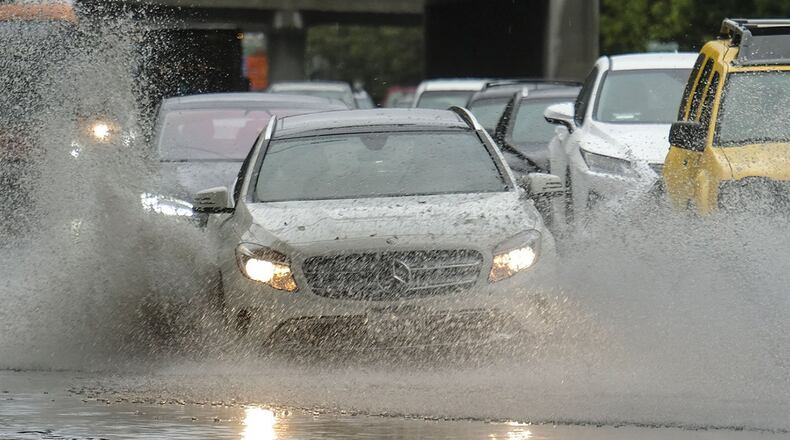Then there are those who disregard their own safety and the safety of others, driving full speed ahead, standing water and limited visibility be damned.
Whether you’re faced with a short-lived cloudburst of rain or a punishing, consistent downpour, here are a few things to keep in mind when driving in monsoon-like conditions:
♦ Make your car is visible as possible. Assuming your vehicle is equipped with daylights or lights that turn on automatically when it’s dark, be sure to turn your headlights on so that your taillights are on as well. Turning your hazards on helps, too. The idea is to improve your own line of vision and to be sure that other drivers can see all four corners of your vehicle.
♦ Keep your brights off. Highbeam lights don’t do much to improve visibility when it’s raining and can impair your own vision and the vision of others because high, intense rays will bounce off the wet, reflective surfaces and into drivers’ eyes.
♦ Keep your distance. Following a car too closely is never a good idea, but it’s especially important to maintain a safe distance when it is raining. You never know when the car in front of you will may have to stop or swerve, so it’s best to give yourself enough room to react accordingly.
This also includes your proximity to the drivers in adjacent lanes. Be especially cautious when in another driver’s blind spot. A quick swerve to avoid another car is much more dangerous when the road conditions aren’t conducive to sudden adjustments.
♦ Pay attention. Despite the many precautions we take, driving can sometimes be a go-through-the-motions activity, especially during long-distance trips. Drivers can be lulled into usual habits – continually adjusting their seat, fidgeting with an iPhone and digging into a bag of Andy Capp Hot Fries – even during heavy rain. But it’s important not to get too comfortable when the weather isn’t cooperating.
♦ Turn off your cruise control, too. Not only is it ineffective and potentially dangerous if your car begins to hydroplane, it can also make you less reliant on your own instincts in case something happens. Above all, remain focused on the road ahead and tune out any distractions that could impact your response time.
♦ Handle hydroplaning. If you remember Driver’s Ed 101, you might recall that a vehicle driving 35 miles per hour through as little as one-twelfth of an inch of water is susceptible to partial hydroplaning, which occurs when a vehicle’s tires lose traction. Standing water can separate the tires of cars traveling 60 miles per hour from the pavement, so it only makes sense to slow down.
If you begin hydroplaning, the American Automobile Association recommends taking your foot off the accelerator slowly and steering in the direction you want the car to go without making any sudden turns. If the vehicle begins to spin, you should slowly turn the wheel in the direction of the spin. Jerking the wheel can cause your car to flip.
About the Author
